
RI Coastal Resources Management Council
...to preserve, protect, develop, and restore coastal resources for all Rhode Islanders

...to preserve, protect, develop, and restore coastal resources for all Rhode Islanders
CRMC aquaculture tours a success
June 6, 2016, CHARLESTOWN – Wind whips over the waters on Ninigret Pond, but the sun is warm and it’s just another day at the office for oyster farmer Nick Papa and his crew.
Papa, the owner of East Beach Farms, has been working on the pond since 2004, and sells his oysters to restaurants nationwide, in addition to a number of eateries in Newport. Papa also has the largest of the oyster farms on this pond; he and his three-person crew work his 6-acre lease from spring until winter. He utilizes an additional 10.95 acres for winter storage, using a bottom plant method (oysters rest on the pond bottom) in deeper pond waters.
“With bottom plant, the challenges are almost non-existent,” said David Beutel, aquaculture coordinator for the R. I. Coastal Resources Management Council, which took members of the public, CRMC staff and Council members, as well as a few reporters, out on a pontoon boat on June 2 to visit a few of the leases on Ninigret.
According to Beutel, most of the aquaculture here is on the washover fan, in two to three feet of water (on the eastern side). The rest of the pond doesn’t get much deeper than six feet. The western side, he said, has very little aquaculture – one lease – in order to minimize user conflicts. The lease on the west side, he said, is in deeper water, and so it presents no user conflicts.
The beauty of bottom plant aquaculture is in its simplicity – no rack and bags, no cages, no gear of any kind. But the lack of space-minimizing gear means that those utilizing this method need more acreage to grow their oysters, Beutel said. Still, the only thing visible to mark these leases is four color-coded buoys, one at each corner.
Papa’s lease might be the largest on Ninigret, but it’s not the largest the CRMC has permitted, as the agency charged with managing Rhode Island’s aquaculture industry. According to Beutel, there is a continuous 40-acre bottom plant area (consisting of three farms) in Point Judith Pond. These larger farms, however, have not pushed the total acreage farmed to the five percent aquaculture limit for each of the coastal ponds.
Towing a skiff behind him loaded with heavy duty plastic crates, Papa wades through his farm and back to a small barge, a floating processing station, where his crew prepares the oysters for market. He gets his seed from Maine, Virginia, and New York, though that could change if Rhode Island’s first shellfish hatchery – permitted by the CRMC – is successful. Papa said it takes about two years for a marketable, good oyster, two to three years, ideally.
When asked by one tour-goer why he didn’t sell to more local eateries, he said, “We typically sell to distributors, but we are getting more Rhode Island restaurants. Forty to 50 percent of the oysters we sell in the summer stay in Rhode Island.” Winter demand is high, too, he said.
One tour participant asks Papa how his season is going so far. He chuckles, shrugs, and says it’s a recovery year, of sorts.
“The tough winter two years ago killed a lot of our stock,” he said. “Sixty percent of our seed was lost.”
As a whole, the aquaculture industry has been making steady gains since 1996 (with the exception of one year, 2000, due to the recession). And the industry continues to grow – not just in farm acreage, farm-gate value and numbers employed, but a host of other secondary developments have taken place that show the industry is a major player in Rhode Island.
Papa and five other farmers have formed the Ocean State Shellfish Cooperative, a self-proclaimed “microbrewery” for oysters, and a way for the group to offer their individual products in larger markets. Christian Durfee is now operating the first commercial Rhode Island shellfish hatchery at Ninigret Landing Marina, and hopes to offer seed grown locally. The number of aquaculture applications coming in to the CRMC has also increased over the last 15 years. In 2015, there were more than seven million oysters harvested.
“The supply of oysters doesn’t begin to meet the demand,” Beutel said.
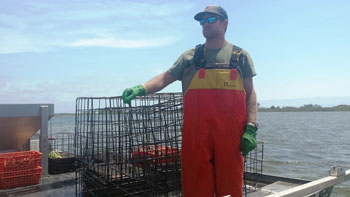
Nick Papa, owner of East Beach Oysters, speaks to people on the aquaculture tours last week.
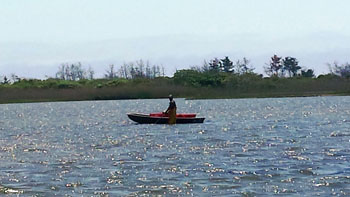
Nick Papa uses a bull rake to harvest oysters on his farm on Ninigret Pond last week.
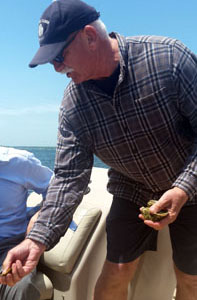
CRMC Aquaculture Coordinator Dave Beutel shows tour participants new growth on oysters from East Beach Farms.
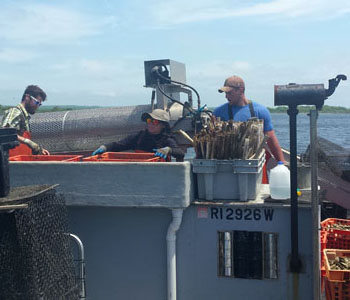
Workers sort and prepare mature oysters from East Beach Farms to go to market.
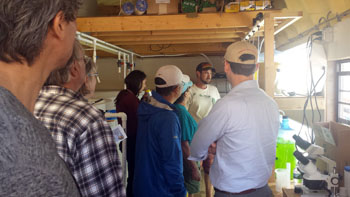
Christian Durfee, center in white shirt, explains his shellfish hatchery operation to the aquaculture tour group last week. Durfee is raising native oyster seed and hopes to sell it locally to farmers.
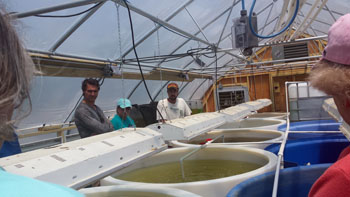
Durfee explains how, using a system that pumps in water from Ninigret Pond, he’s growing algae for his oyster seed.